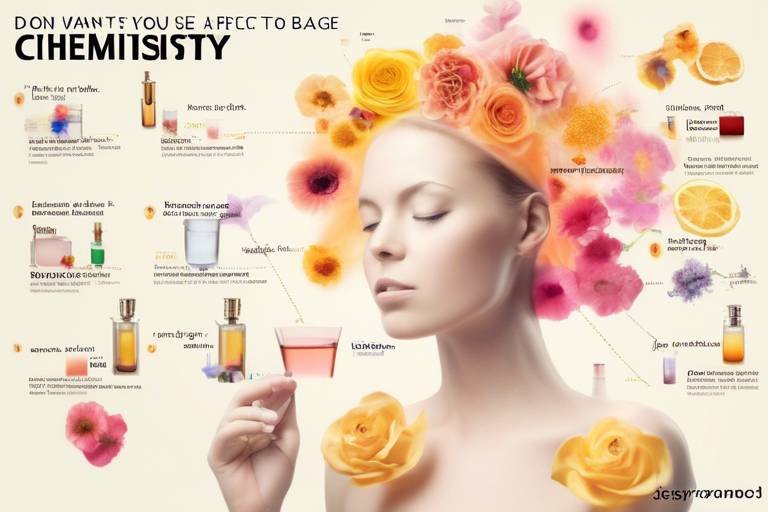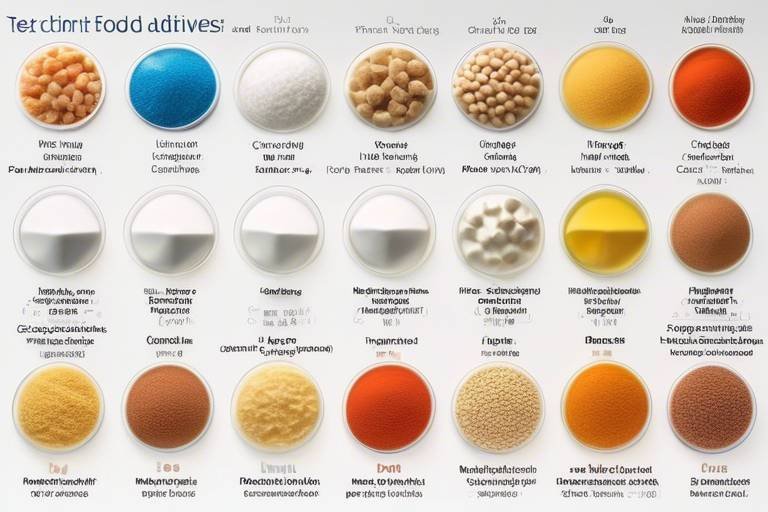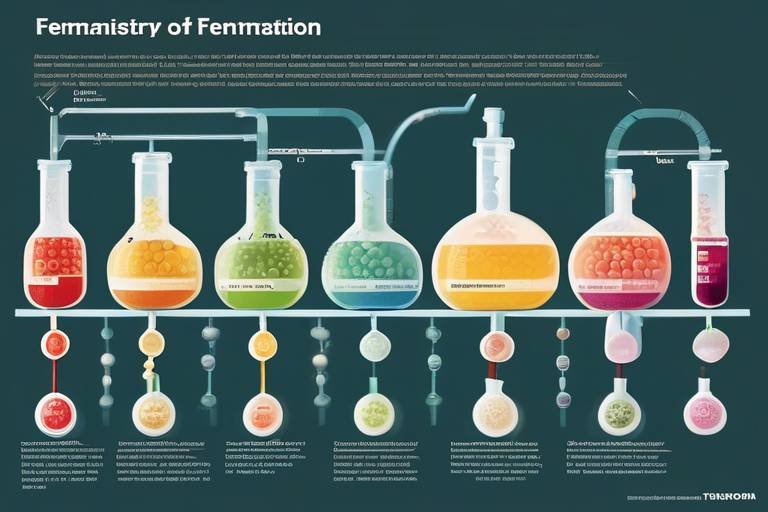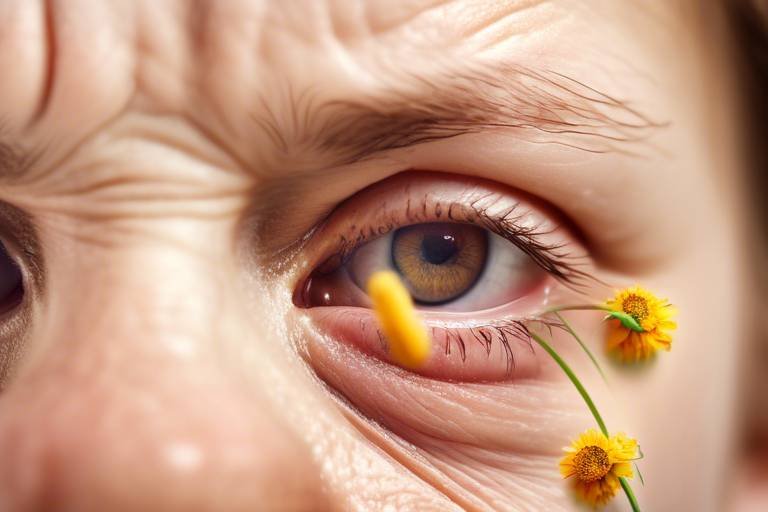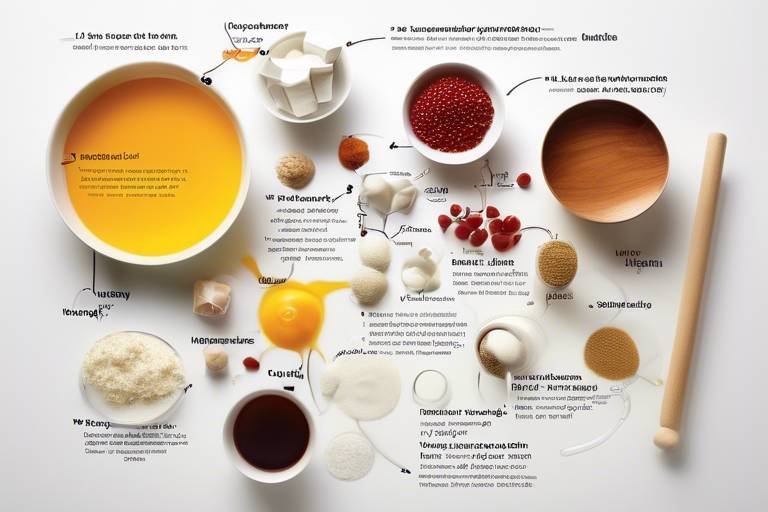The Chemistry of Perfumes - What’s in Your Scent?
Have you ever caught a whiff of a scent that instantly transported you back to a cherished memory? Perhaps the aroma of fresh flowers reminds you of a summer garden, or a hint of vanilla takes you back to your grandmother's kitchen. The magic behind these experiences lies in the intricate chemistry of perfumes. In this article, we’ll dive deep into the fascinating world of fragrance, exploring the chemical composition, the role of various ingredients, and how they interact to create the scents we adore.
To truly appreciate the artistry of perfumes, it's essential to understand the fundamental principles of fragrance chemistry. At its core, perfume creation is an intricate blend of art and science. The perfume industry employs a unique vocabulary, with terms like notes, accords, and sillage frequently thrown around. But what do these terms really mean? Notes refer to the different layers of scent that unfold over time, while accords are harmonious blends of multiple notes. Sillage, on the other hand, describes the trail of scent that lingers in the air after a person has left the room. Understanding these concepts provides a solid foundation for exploring the enchanting world of perfumes.
Perfumes are crafted from a diverse array of ingredients, including essential oils, aroma compounds, and solvents. Each component plays a vital role in shaping a fragrance's unique profile. Let's break it down:
Essential oils are the heart and soul of many perfumes, derived from natural sources like flowers, fruits, and spices. These potent extracts not only provide captivating fragrances but also carry therapeutic properties. The extraction of essential oils can be quite complex, involving methods such as distillation and cold pressing, each affecting the oil's quality and scent profile. For instance, steam distillation is a common technique used for extracting oils from plants like lavender and peppermint, while cold pressing is often used for citrus fruits.
Different techniques yield different qualities of essential oils. Here’s a quick comparison:
| Extraction Method | Common Uses | Quality |
|---|---|---|
| Steam Distillation | Lavender, Rosemary | High Quality |
| Cold Pressing | Citrus Oils | High Quality |
| Solvent Extraction | Jasmine, Tuberose | Medium to High Quality |
Beyond their fragrant allure, essential oils are celebrated for their therapeutic benefits. For example, lavender oil is renowned for its calming properties, making it a popular choice in both perfumery and aromatherapy. In this way, essential oils serve a dual purpose, enhancing our emotional well-being while also delighting our senses.
In the world of modern perfumery, synthetic aroma compounds have become indispensable. These man-made ingredients allow perfumers to create unique scents that might not be achievable with natural ingredients alone. While some argue that synthetic compounds lack the depth and character of natural oils, they offer consistency and versatility. Moreover, they can be produced in a more sustainable manner, reducing the strain on natural resources.
Alcohol is a crucial component in most perfumes, serving as a carrier for fragrance oils. It helps to disperse the scent and enhances its longevity on the skin. The type of alcohol used can significantly influence the overall fragrance experience, as it affects the evaporation rate and the way the scent is perceived. For instance, ethanol is the most common alcohol used in perfumery, known for its ability to evaporate quickly, allowing the fragrance to unfold beautifully.
Different types of alcohol bring different characteristics to a fragrance. Here are some common types:
- Ethanol: The most widely used alcohol in perfumes, known for its quick evaporation.
- Isopropyl Myristate: Often used in oil-based fragrances, providing a smooth application.
- Denatured Alcohol: Commonly used for commercial perfumes, as it is less expensive and still effective.
The rate at which alcohol evaporates is a key factor in how a perfume is experienced. When you spray perfume, the alcohol evaporates quickly, allowing the top notes to be perceived first. As the alcohol dissipates, the middle notes emerge, followed by the base notes, creating a complex and evolving scent journey. This process is akin to a symphony, where each section plays its part in a harmonious blend of aromas.
Perfumes are categorized into various fragrance families, each with its own distinct characteristics. Understanding these families can help you find the scents that resonate with you the most. The main fragrance families include floral, fruity, oriental, woody, and fresh. Each family has its own unique personality, influencing how a perfume is perceived and enjoyed.
Every perfume is a carefully crafted composition, consisting of top, middle, and base notes. The top notes are the initial scents that greet your nose, often light and refreshing. As these fade, the middle notes take center stage, providing the heart of the fragrance. Finally, the base notes settle in, offering depth and longevity. This layered structure is what creates a rich and complex olfactory experience.
If you're feeling adventurous, layering different scents can create a personalized fragrance experience. This technique involves combining multiple perfumes to develop a unique scent that reflects your personality. Think of it as mixing colors on a palette to create a masterpiece. Experimenting with layering can lead to delightful surprises, as some scents complement each other beautifully, while others may clash.
1. What are the main components of a perfume?
Perfumes typically consist of essential oils, synthetic aroma compounds, and alcohol, each contributing to the overall scent profile.
2. How do I choose the right fragrance for me?
Consider your personal preferences and the occasions for which you'll wear the fragrance. Testing scents on your skin can help you find the perfect match.
3. Are synthetic fragrances harmful?
While some people may have sensitivities to certain synthetic compounds, many are safe and used widely in the industry. Always check for allergens if you have sensitivities.
4. How can I make my perfume last longer?
Applying perfume to pulse points, using unscented moisturizers, and storing your fragrance in a cool, dark place can help enhance longevity.

The Basics of Fragrance Chemistry
Understanding the fundamental principles of fragrance chemistry is essential for grasping how perfumes are formulated. At its core, fragrance chemistry involves the study of the various chemical components that come together to create the scents we adore. It’s a fascinating blend of art and science, where creativity meets analytical thinking. Just imagine a painter mixing colors on a palette; similarly, perfumers blend different ingredients to achieve a harmonious scent that resonates with our emotions and memories.
One of the key concepts in fragrance chemistry is the notion of volatile compounds. These are the molecules that evaporate quickly, allowing us to perceive their scent. When you spritz on your favorite perfume, it’s these volatile compounds that travel through the air and reach your nose, triggering your olfactory receptors. Isn’t it amazing how a simple spray can evoke memories or feelings? This is largely due to the intricate way these compounds interact with our brain.
In addition to volatile compounds, we also have fragrance notes. Think of these as the different layers of a song. Just like a melody has a rhythm, perfumes have top, middle, and base notes. The top notes are what you smell immediately after application; they are light and fleeting. Middle notes emerge shortly after and form the heart of the fragrance, while base notes are the lingering scents that provide depth and richness. This layered structure is what makes a fragrance complex and intriguing, much like a well-crafted story.
Moreover, the interaction between these notes is influenced by factors such as temperature and skin chemistry. Just as a dish can taste different based on the ingredients and cooking methods used, a perfume can smell different on various individuals. This is due to the unique pH levels and body temperature of each person, which can alter how the fragrance develops on their skin.
In essence, fragrance chemistry is a dynamic field that combines various scientific disciplines, such as organic chemistry and biochemistry. It’s not just about mixing scents; it’s about understanding how different molecules react with one another and with our bodies. The next time you spritz on your favorite scent, take a moment to appreciate the intricate dance of chemicals that create that delightful experience!
- What are volatile compounds in perfumes? Volatile compounds are the molecules that evaporate quickly, allowing us to perceive their scent.
- What are fragrance notes? Fragrance notes are the different layers of a perfume, including top, middle, and base notes that create a complex scent experience.
- How does skin chemistry affect fragrance? Individual skin chemistry, including pH levels and body temperature, can alter how a fragrance develops and smells on different people.

Key Ingredients in Perfumes
When it comes to the enchanting world of perfumes, the magic lies in the ingredients that blend together to create those captivating scents we adore. Perfumes are not just a simple mix of odors; they are intricate compositions that tell a story through their aroma. The key ingredients can be broadly categorized into three main groups: essential oils, synthetic aroma compounds, and solvents. Each of these components plays a vital role in shaping the final fragrance, contributing to its unique profile and longevity.
Essential oils are perhaps the most celebrated ingredients in perfumery. These natural extracts are derived from plants, flowers, and even fruits, capturing their essence in a bottle. The extraction methods used to obtain these oils can greatly influence their quality and scent. For instance, oils extracted through steam distillation can vary significantly from those obtained via cold pressing, which is often used for citrus fruits. The purity and potency of these oils are crucial, as they form the backbone of many popular fragrances.
On the other hand, synthetic aroma compounds have revolutionized the perfume industry. These man-made ingredients allow perfumers to create scents that are not only unique but also consistent. While some purists argue that synthetic compounds lack the depth of natural ingredients, they offer a plethora of advantages. For example, they can replicate rare scents that are difficult or impossible to source naturally, such as certain floral notes or exotic woods. This flexibility enables perfumers to experiment and innovate, leading to an array of fragrances that cater to diverse preferences.
Moreover, solvents, particularly alcohol, are essential in the formulation of perfumes. Alcohol serves as a carrier for the fragrance oils, helping to disperse the scent evenly when applied to the skin. The type of alcohol used can influence not only the scent's longevity but also how it interacts with the skin's chemistry. For instance, ethanol is the most commonly used alcohol in perfumes due to its ability to evaporate quickly, allowing the fragrance to unfold in layers. This evaporation process is a crucial aspect of how we experience a scent over time.
In summary, the ingredients that go into crafting a perfume are diverse and complex. Each component, whether it’s a natural essential oil, a synthetic compound, or a solvent, contributes to the overall experience of the fragrance. The art of perfumery is not just about mixing scents; it's about understanding how these ingredients interact, evolve, and create an emotional connection with the wearer. The next time you spritz on your favorite fragrance, take a moment to appreciate the intricate dance of ingredients that makes it so special.
- What are essential oils? Essential oils are concentrated natural extracts from plants, used in perfumes for their aromatic qualities.
- Are synthetic aroma compounds safe? Yes, synthetic aroma compounds are rigorously tested for safety and are widely used in the fragrance industry.
- Why is alcohol used in perfumes? Alcohol acts as a solvent that helps disperse the fragrance oils and enhances the scent's longevity.
- Can perfumes contain both natural and synthetic ingredients? Absolutely! Many modern perfumes blend both to achieve a balanced and unique fragrance profile.

Essential Oils
Essential oils are the heart and soul of many perfumes, acting as the aromatic powerhouses that give each fragrance its unique character. Derived from various parts of plants—such as flowers, leaves, bark, and roots—these oils capture the essence of nature in a concentrated form. Imagine walking through a lush garden filled with blooming flowers or a dense forest brimming with fresh pine; that vibrant, invigorating scent is distilled into essential oils, allowing us to carry a piece of that experience with us wherever we go.
The extraction of these aromatic compounds is an art in itself, often involving intricate methods designed to preserve their delicate qualities. Some of the most common extraction techniques include:
- Steam Distillation: This method uses steam to extract oils from plant materials. The steam passes through the plant, causing the oils to evaporate, and then cools to condense back into liquid form.
- Cold Pressing: Primarily used for citrus fruits, this technique extracts oils by mechanically pressing the rinds, releasing the fragrant oils without the use of heat.
- Solvent Extraction: For delicate flowers that cannot withstand heat, solvents are used to dissolve the essential oils, which are then separated from the solvent, yielding a highly fragrant product.
These extraction methods significantly impact the quality and aroma of the essential oils produced. For instance, steam distillation is known for producing high-quality oils with a purer scent profile, while solvent extraction may yield more complex fragrances due to the inclusion of additional aromatic compounds. The choice of extraction method can mean the difference between a rich, vibrant scent and a flat, lifeless one.
Beyond their delightful aromas, essential oils also bring a wealth of therapeutic benefits to the table. Many of them are celebrated for their healing properties, which can enhance both physical and emotional well-being. For example, lavender oil is renowned for its calming effects, making it a popular choice in aromatherapy for reducing stress and promoting relaxation. Similarly, peppermint oil is often used for its invigorating properties, helping to boost energy levels and mental clarity.
In perfumery, the dual role of essential oils as both fragrance and therapeutic agents opens up a world of possibilities. Not only do they create captivating scents, but they can also influence mood and feelings, making the experience of wearing perfume a holistic one. Imagine spritzing on a floral fragrance that not only smells divine but also uplifts your spirits—it's like wearing a little bottle of happiness!
In conclusion, essential oils are not just mere ingredients in the world of perfumery; they are the essence of what makes a fragrance truly captivating. Their complex extraction processes, combined with their aromatic and therapeutic properties, create a rich tapestry of scents that can transform our mood and environment. So the next time you apply your favorite perfume, take a moment to appreciate the incredible journey of the essential oils within it, and how they contribute to the delightful experience of scent.
What are essential oils?
Essential oils are concentrated plant extracts that capture the natural fragrance and properties of the plant. They are used in perfumes for their aromatic qualities and therapeutic benefits.
How are essential oils extracted?
Essential oils are extracted through various methods, including steam distillation, cold pressing, and solvent extraction. Each method affects the quality and scent of the oil.
Can essential oils be used in aromatherapy?
Yes, essential oils are widely used in aromatherapy for their therapeutic properties. They can promote relaxation, boost mood, and enhance overall well-being.

Extraction Methods
When it comes to crafting the perfect perfume, the journey begins with the extraction of essential oils, which are the lifeblood of fragrance. There are several methods employed to extract these aromatic compounds from plants, each with its unique advantages and characteristics. Understanding these methods not only helps in appreciating the art of perfumery but also sheds light on the quality and complexity of the scents we adore.
One of the most traditional methods is steam distillation. This technique involves passing steam through plant materials, which causes the essential oils to evaporate. The steam is then cooled, and the oils are collected as they condense. This method is widely used because it preserves the delicate aromas and therapeutic properties of the oils. However, it can be time-consuming and may not be suitable for all types of plants.
Cold pressing is another popular method, primarily used for citrus fruits. In this process, the peels are mechanically pressed to release the essential oils. This method is beloved for its ability to capture the bright, zesty notes of citrus, resulting in oils that are vibrant and fresh. However, it can only be applied to specific types of plants, limiting its use in the broader perfume industry.
Additionally, there are solvent extraction and CO2 extraction methods that are gaining traction. Solvent extraction involves using a solvent to dissolve the essential oils from the plant material, which is then evaporated, leaving behind a concentrated oil. This method is particularly useful for delicate flowers that cannot withstand the heat of distillation. On the other hand, CO2 extraction uses carbon dioxide under high pressure to extract oils, resulting in a high-quality product that retains the full spectrum of the plant's aroma. This method is often considered superior due to its ability to capture the essence of the plant without altering its chemical structure.
Here’s a quick comparison of the different extraction methods:
| Extraction Method | Best For | Advantages | Disadvantages |
|---|---|---|---|
| Steam Distillation | Hardy plants (e.g., lavender) | Preserves aroma and properties | Time-consuming |
| Cold Pressing | Citrus fruits (e.g., oranges) | Captures bright, zesty notes | Limited to specific plants |
| Solvent Extraction | Delicate flowers (e.g., jasmine) | High yield of aromatic compounds | May leave solvent residues |
| CO2 Extraction | Variety of plants | High-quality, full-spectrum oils | More expensive equipment |
In conclusion, the extraction method chosen can significantly influence the quality and characteristics of the essential oils used in perfumes. Each technique has its unique benefits and challenges, making the selection process a crucial step in the fragrance creation journey. As you explore different perfumes, you might find yourself more aware of the intricate processes behind the scents you love, enhancing your appreciation for the artistry involved in perfumery.

Uses of Essential Oils
Essential oils are not merely the fragrant soul of perfumes; they also serve a multitude of purposes that extend far beyond just making us smell good. Imagine walking through a lush garden, where every flower and herb offers its unique aroma, and you can almost feel the benefits wafting through the air. These concentrated plant extracts are packed with therapeutic properties that can enhance our physical and emotional well-being.
One of the most popular uses of essential oils is in aromatherapy, a holistic healing practice that utilizes the natural scents to promote health and well-being. For instance, lavender oil is renowned for its calming effects, often used to alleviate stress and anxiety. Similarly, peppermint oil can invigorate the mind and improve focus, making it a favorite among students and professionals alike.
Additionally, essential oils are frequently incorporated into skincare products. Their natural antibacterial and anti-inflammatory properties make them ideal for treating various skin conditions. For example, tea tree oil is celebrated for its ability to combat acne, while rose oil is cherished for its moisturizing and soothing effects on the skin. This dual role of essential oils in both perfumery and skincare highlights their versatility and importance in our daily lives.
Moreover, essential oils can also be used for household cleaning. Many people are turning to natural cleaning solutions that incorporate essential oils like lemon and eucalyptus, known for their antiseptic properties. Not only do these oils help in disinfecting surfaces, but they also leave behind a refreshing scent that artificial cleaners often lack.
In the culinary world, essential oils are gaining traction as flavoring agents. For instance, culinary-grade peppermint oil can elevate the taste of desserts and beverages, providing a potent burst of flavor that dried herbs may not offer. However, it’s crucial to use these oils sparingly, as they are much more concentrated than their herbal counterparts.
In summary, the uses of essential oils are vast and varied, ranging from enhancing our mood and improving our skin to cleaning our homes and flavoring our food. Their multifaceted nature not only enriches our lives but also reinforces the importance of these natural extracts in both perfumery and beyond.
- What are essential oils? Essential oils are concentrated extracts from plants, capturing their natural fragrance and therapeutic properties.
- Can essential oils be used safely on the skin? Yes, but they should be diluted with a carrier oil to prevent skin irritation.
- How do essential oils benefit mental health? Many essential oils have calming or uplifting properties that can help reduce stress and anxiety.
- Are all essential oils safe for ingestion? No, not all essential oils are safe to ingest. Only food-grade essential oils should be used for culinary purposes.

Synthetic Aroma Compounds
Synthetic aroma compounds have revolutionized the world of perfumery, bringing with them a plethora of unique scents that nature alone could not provide. These compounds are created in laboratories and can mimic natural fragrances or create entirely new ones that evoke emotions and memories. The beauty of synthetic aromas lies in their versatility; they can be tailored to achieve specific scent profiles that are consistent and long-lasting. But what exactly are these compounds, and why are they so essential in modern perfumery?
One of the primary advantages of synthetic aroma compounds is their ability to provide consistency in fragrance. Unlike natural extracts, which can vary in scent and quality based on factors like climate and soil conditions, synthetic compounds are manufactured to ensure that every batch of perfume smells exactly the same. This reliability is crucial for both consumers and manufacturers. Imagine buying a beloved perfume only to find that the scent has changed from one bottle to the next! Synthetic compounds eliminate this inconsistency, making them a favorite among perfumers.
Moreover, synthetic aroma compounds often allow perfumers to create scents that would be impossible to extract from nature. For instance, the delightful smell of a fresh rainstorm or the aroma of a ripe fruit can be synthesized to perfection, providing a sensory experience that captures the essence of these moments. The creativity involved in using synthetic compounds is akin to painting with a broader palette, enabling perfumers to craft fragrances that are innovative and imaginative.
However, the use of synthetic aroma compounds is not without controversy. Some consumers prefer natural ingredients, believing that they are safer and more environmentally friendly. There is an ongoing debate about the potential health effects of synthetic compounds, with some arguing that they can cause allergic reactions or skin irritations. It's essential to note that regulatory bodies closely monitor the safety of these ingredients, and many synthetic compounds are deemed safe for use in cosmetics and perfumes.
In the world of perfumery, the balance between natural and synthetic ingredients is often a topic of discussion. Many modern fragrances incorporate both, leveraging the strengths of each type to create a well-rounded scent. For instance, a perfume might feature natural essential oils for warmth and depth while using synthetic compounds to enhance freshness or add complexity. This harmonious blend illustrates the artistry of perfumery, where science meets creativity.
In summary, synthetic aroma compounds play a pivotal role in the fragrance industry, offering consistency, innovation, and the ability to create captivating scents that resonate with consumers. As the industry evolves, the dialogue between natural and synthetic ingredients continues, allowing for exciting developments in the world of perfume. Whether you prefer the allure of natural extracts or the boldness of synthetic aromas, there's no denying that these compounds contribute significantly to the scents we cherish.
- What are synthetic aroma compounds?
Synthetic aroma compounds are artificially created substances that mimic natural scents or create entirely new fragrances. - Are synthetic aroma compounds safe?
Yes, synthetic aroma compounds are regulated for safety, and many are considered safe for use in perfumes and cosmetics. - Do synthetic compounds smell different from natural ones?
While they can replicate natural scents, synthetic compounds often provide a more consistent and sometimes enhanced aroma. - Can I find perfumes that use both natural and synthetic ingredients?
Absolutely! Many modern perfumes blend both types to achieve a balanced and complex fragrance profile.

The Role of Alcohol in Perfumes
When you spritz on your favorite fragrance, have you ever wondered what makes that delightful scent linger in the air? The answer lies significantly in the role of alcohol. This unsung hero of perfumery not only acts as a carrier for the fragrance oils but also plays a crucial part in the overall sensory experience. Alcohol helps to disperse the scent evenly, allowing it to envelop you in a captivating aura. Imagine alcohol as the vehicle that transports the essence of the perfume from the bottle to your skin, making the magic happen.
In the world of perfumery, alcohol serves multiple functions. It enhances the fragrance's volatility, which means it helps the scent to evaporate at varying rates, releasing different notes over time. This evaporation process is essential for the development of the scent. As the alcohol evaporates, it carries the fragrance molecules into the air, allowing you and those around you to experience the perfume's complexity. This is why a perfume can smell different when first applied compared to how it lingers hours later.
Moreover, the type of alcohol used can significantly affect the perfume's overall characteristics. The most common type of alcohol found in perfumes is ethanol, but there are variations that perfumers may choose based on the desired outcome. Below is a comparison of the most popular types of alcohol used in perfumery:
| Type of Alcohol | Properties | Common Uses |
|---|---|---|
| Ethanol | Fast evaporating, neutral scent | Most common in perfumes |
| Isopropyl Alcohol | Stronger scent, slower evaporation | Used in some body sprays |
| Denatured Alcohol | Non-toxic, often mixed with other substances | Common in cheaper fragrances |
While alcohol is essential, it’s important to note that it can also have some downsides. For instance, alcohol can be drying to the skin, which is why many high-end perfumes often include moisturizing agents to counteract this effect. Additionally, some individuals may be sensitive to alcohol, leading to skin irritation or allergic reactions. Thus, understanding the role of alcohol in perfumes is crucial not only for consumers but also for those who are formulating scents.
In conclusion, alcohol is much more than just a simple ingredient in your favorite fragrance; it’s a vital component that influences how a scent is perceived and experienced. From its ability to enhance the volatility of fragrance notes to its role in delivering a smooth application, alcohol is indeed the backbone of modern perfumery. Next time you apply your perfume, take a moment to appreciate this essential element that makes your scent journey possible!
- Why is alcohol used in perfumes? Alcohol acts as a carrier for fragrance oils, helping to disperse the scent and enhance its longevity.
- What types of alcohol are commonly found in perfumes? The most common types include ethanol, isopropyl alcohol, and denatured alcohol.
- Can alcohol in perfumes cause skin irritation? Yes, some individuals may experience irritation, especially if they have sensitive skin.
- Does the type of alcohol affect the scent of the perfume? Absolutely! Different types of alcohol can influence the evaporation rate and overall fragrance experience.

Types of Alcohol Used
When it comes to crafting the perfect perfume, one of the unsung heroes is alcohol. It's not just a simple solvent; it plays a crucial role in how a fragrance is experienced. The type of alcohol used can greatly influence the scent's longevity, projection, and overall character. In the world of perfumery, there are several types of alcohol that are commonly utilized, each with its own unique properties.
The most prevalent type of alcohol found in perfumes is ethanol. This alcohol is favored for its ability to evaporate quickly, allowing the fragrance to disperse into the air effectively. Ethanol is often derived from natural sources, such as sugarcane or grains, making it a versatile choice for many perfumers. Its rapid evaporation helps to release the top notes of a fragrance, which are the initial scents you perceive when you first spray a perfume.
Another type of alcohol that is occasionally used is isopropyl myristate. While it’s not as common as ethanol, it serves a specific purpose in certain formulations. Isopropyl myristate is known for its ability to enhance the skin absorption of fragrances, making it a great choice for products designed to be worn on the skin. However, it's worth noting that this type of alcohol can alter the scent profile, sometimes muting the fragrance's more delicate notes.
Additionally, some niche perfumers experiment with denatured alcohol. This is ethanol that has been treated to make it unsuitable for consumption, thus avoiding certain taxes and regulations. Denatured alcohol can have a slightly different scent profile than pure ethanol, which can add a unique twist to the fragrance. However, it’s essential for perfumers to balance this with the overall scent experience they aim to create.
Here's a quick comparison of the different types of alcohol used in perfumes:
| Type of Alcohol | Properties | Common Uses |
|---|---|---|
| Ethanol | Fast evaporation, natural source | Most perfumes |
| Isopropyl Myristate | Enhances absorption, alters profile | Skin applications |
| Denatured Alcohol | Unique scent profile, tax benefits | Niche perfumes |
Understanding these different types of alcohol can help you appreciate the artistry behind your favorite fragrances. The right alcohol not only aids in scent dispersal but also contributes to the overall sensory experience of wearing a perfume. So, next time you spritz on your favorite scent, take a moment to think about the role that alcohol plays in bringing that fragrance to life.
- Why is alcohol used in perfumes? Alcohol acts as a carrier for fragrance oils, helping to disperse the scent effectively and enhancing evaporation.
- Can I wear perfume without alcohol? Yes, there are alcohol-free options available, typically using oil bases instead; however, they may have different scent profiles and longevity.
- Is there a difference between natural and synthetic alcohol in perfumes? Yes, natural alcohol is derived from plants, while synthetic alcohol is chemically produced. Both can have different effects on the fragrance.

Evaporation and Scent Release
When you spritz your favorite perfume, what happens next is nothing short of a magical transformation. The process of evaporation plays a pivotal role in how we perceive scents. As the alcohol in the perfume evaporates, it carries the fragrance molecules into the air, creating the delightful aroma that envelops you. This phenomenon isn't just a simple release; it's a carefully orchestrated dance of chemistry that determines how long and how well a scent lasts.
Imagine a beautiful sunset. The colors shift and change as the light fades, much like how a perfume evolves as it interacts with your skin and the surrounding environment. The rate of evaporation is influenced by several factors, including temperature, humidity, and even the type of skin you have. For instance, warmer skin tends to enhance the evaporation rate, allowing the top notes of a fragrance to burst forth more quickly. On the other hand, cooler temperatures can slow down this process, leading to a more subdued scent experience.
To understand the nuances of evaporation and scent release, let's break it down into three main phases:
- Top Notes: These are the first scents you smell immediately after applying the perfume. They are typically light and refreshing, often composed of citrus or herbal elements. However, they evaporate quickly, usually within the first 15 minutes.
- Middle Notes: Also known as heart notes, these emerge after the top notes fade. They form the core of the fragrance and last longer, usually from 20 minutes to several hours. Floral and fruity scents often dominate this category.
- Base Notes: These provide depth and richness to the fragrance. They are the last to evaporate and can linger on the skin for hours, sometimes even days. Common base notes include vanilla, musk, and sandalwood.
In addition to the notes, the composition of the perfume significantly affects its evaporation rate. For example, perfumes with a higher concentration of essential oils tend to evaporate more slowly than those with a higher alcohol content. This is why parfum (or extrait) lasts longer than eau de toilette or eau de cologne. In a sense, the concentration of fragrance oils acts as a buffer, slowing down the release of scent and allowing for a more prolonged experience.
Furthermore, the environment plays a crucial role in how a fragrance is experienced. High humidity can enhance scent perception, making the fragrance feel more intense, while dry conditions may cause the scent to dissipate more quickly. This is why your favorite perfume may smell different on a hot summer day compared to a chilly winter evening.
Understanding the intricacies of evaporation and scent release not only enriches your appreciation of perfumes but also helps you choose the right fragrance for the right occasion. Whether you prefer a light, airy scent for daytime or a deeper, more sensual fragrance for evening wear, knowing how evaporation works can guide your choices.
Q: How long does a perfume last on the skin?
A: The longevity of a perfume on the skin varies based on its concentration, skin type, and environmental conditions. Typically, perfumes last anywhere from 3 to 8 hours, depending on these factors.
Q: Can I make my perfume last longer?
A: Yes! To extend the life of your fragrance, apply it to pulse points, layer it with matching scented lotions, and store it in a cool, dark place to prevent degradation.
Q: What is the difference between eau de parfum and eau de toilette?
A: Eau de parfum contains a higher concentration of fragrance oils (usually 15-20%) than eau de toilette (typically 5-15%). This means eau de parfum lasts longer and has a stronger scent.
Q: Why do some perfumes smell different on my skin?
A: Individual skin chemistry, including pH levels and body temperature, can alter how a fragrance develops and smells once applied, leading to variations in scent.

Fragrance Families and Notes
When it comes to perfumes, understanding fragrance families and the concept of notes is crucial for anyone looking to navigate the enchanting world of scents. Fragrance families categorize perfumes based on their dominant aromatic characteristics. Think of it as sorting music into genres: just as you have rock, pop, and classical, perfumes can be grouped into families like floral, oriental, citrus, and woody. Each family evokes different emotions and memories, making the experience of selecting a perfume both personal and exciting.
Within these fragrance families, perfumes are further dissected into three distinct layers known as top notes, middle notes, and base notes. Each layer plays a vital role in the overall scent experience. The top notes are what you smell immediately upon application. They are typically fresh and light, composed of citrus or fruity scents that create an initial impression. However, they are fleeting, often dissipating within the first 15 to 30 minutes.
As the top notes fade, the middle notes emerge, forming the heart of the fragrance. These notes are more robust and can include floral, spicy, or herbal elements. They usually last for a few hours and are essential in defining the perfume's character. For instance, a floral perfume might reveal notes of jasmine or rose in this stage, creating a romantic and inviting aura.
Finally, we have the base notes, which provide depth and longevity to the fragrance. These notes are typically rich and heavy, often consisting of ingredients like musk, amber, or sandalwood. Base notes can linger on the skin for hours, sometimes even days, offering a lasting impression long after the initial spritz. Think of them as the foundation of a beautiful building; without them, the structure wouldn't stand strong.
The interplay between these notes is what makes perfume so fascinating. Each layer not only contributes to the overall scent but also interacts with the wearer's body chemistry, creating a unique fragrance experience. This is why two people can wear the same perfume and have it smell different on their skin. It's a beautiful dance of chemistry and artistry!
For those interested in exploring the fragrance families further, here’s a quick overview:
| Fragrance Family | Description |
|---|---|
| Floral | Characterized by the scent of flowers; often sweet and romantic. |
| Oriental | Rich and warm, featuring spices, resins, and exotic ingredients. |
| Citrus | Fresh and zesty, with notes of lemon, orange, and other citrus fruits. |
| Woody | Earthy and warm, with notes of cedar, sandalwood, and vetiver. |
Layering fragrances can also enhance your scent experience. By combining different perfumes, you can create a signature scent that reflects your personality. For example, mixing a floral perfume with a woody one can result in a beautiful balance of sweetness and earthiness, making it uniquely yours. Experimentation is key here; just like mixing colors on a palette, the right combination can yield a masterpiece!
In conclusion, understanding fragrance families and notes not only enriches your appreciation of perfumes but also empowers you to make informed choices when selecting your next scent. Whether you prefer the lightness of citrus or the warmth of oriental fragrances, there's a whole world of aromas waiting to be discovered!
- What are the main fragrance families? The main fragrance families include floral, oriental, citrus, and woody.
- How long do different notes last in a perfume? Top notes last about 15-30 minutes, middle notes last a few hours, and base notes can linger for hours or even days.
- Can two people wearing the same perfume smell different? Yes, individual body chemistry can alter how a fragrance smells on different people.

Top, Middle, and Base Notes
When you spritz on your favorite perfume, have you ever wondered why it smells different over time? This fascinating shift in scent is all thanks to the **three layers** of fragrance known as top, middle, and base notes. Each of these layers plays a crucial role in how a perfume unfolds on your skin, creating a complex and dynamic olfactory experience that can be likened to a well-composed symphony.
Let’s break it down, shall we? The **top notes** are the first impressions of a fragrance, the initial burst of scent that greets your senses. These are typically light, fresh, and volatile compounds that evaporate quickly. Think of citrusy lemon or crisp green apple. They are designed to captivate your attention right away, but don’t get too attached; they usually fade within the first 15 to 30 minutes. Imagine meeting someone at a party who dazzles you with their charm but leaves you wanting more once they move on.
Next comes the **middle notes**, also known as the heart notes. This layer emerges as the top notes dissipate, revealing a richer and more rounded scent profile. Middle notes are often floral or fruity, such as jasmine or peach, and they can last for several hours. They are the backbone of the fragrance, providing depth and character. If the top notes are the charming party-goer, the middle notes are the friend who engages you in meaningful conversation, making the experience more memorable.
Finally, we arrive at the **base notes**, which form the foundation of the fragrance. These notes are heavier and longer-lasting, often comprised of rich, warm ingredients like vanilla, sandalwood, or amber. Base notes can linger on the skin for hours, sometimes even days, leaving a lasting impression. They are akin to the comforting presence of a close friend who stays by your side, providing stability and warmth long after the initial excitement has faded.
To give you a clearer idea of how these notes work together, here's a simple table that outlines their characteristics:
| Note Type | Characteristics | Examples | Duration |
|---|---|---|---|
| Top Notes | Light, fresh, and volatile | Citrus, herbs, light fruits | 15-30 minutes |
| Middle Notes | Rich, floral, and balanced | Jasmine, rose, spices | 30 minutes to 3 hours |
| Base Notes | Deep, warm, and lasting | Vanilla, musk, woods | 3 hours to 24+ hours |
Understanding these notes not only enhances your appreciation for perfumes but also helps you choose scents that resonate with you throughout the day. Whether you're looking for something refreshing for a sunny afternoon or a deep, sultry scent for an evening out, knowing how to navigate the world of top, middle, and base notes can make all the difference. So next time you indulge in a new fragrance, take a moment to savor the unfolding story of scents as they evolve on your skin!
- What are top notes? Top notes are the initial scents you smell when you first apply a fragrance. They are usually light and evaporate quickly.
- How long do middle notes last? Middle notes typically last from 30 minutes to a few hours after application.
- What role do base notes play in a perfume? Base notes provide depth and longevity to a fragrance, often lingering for several hours or even days.
- Can I layer different perfumes? Yes! Layering different scents can create a unique and personalized fragrance experience.

Layering Fragrances
Layering fragrances is like creating a delicious recipe; it’s all about finding the perfect balance of scents that complement each other. Just as a chef combines spices to elevate a dish, you can mix different perfumes to craft a unique signature scent that reflects your personality. The art of layering allows you to express your individuality, making each application a personal statement. But how do you go about it? Let’s dive into some tips and tricks that can help you master this olfactory art.
First off, it’s essential to understand that not all fragrances are created equal. Some scents are stronger and more dominant, while others are lighter and more delicate. A good rule of thumb is to start with a base fragrance that you love. This will serve as the foundation of your layered scent. Once you have your base, you can choose a middle note to add complexity. Finally, finish with a top note that provides an initial burst of freshness. This layering technique not only enhances the fragrance but also extends its longevity, as the different layers will evolve over time.
When layering, consider the fragrance families of the perfumes you’re using. For instance, combining floral and fruity scents can create a vibrant and uplifting aroma, while mixing woody and oriental fragrances can result in a warm and inviting scent profile. Here’s a quick breakdown of some popular fragrance families you might want to consider:
| Fragrance Family | Description |
|---|---|
| Floral | Romantic and feminine, featuring notes of flowers like rose and jasmine. |
| Fruity | Sweet and juicy, with scents like peach, apple, and berry. |
| Woody | Earthy and rich, including notes like sandalwood and cedar. |
| Oriental | Warm and spicy, often featuring notes like vanilla, amber, and musk. |
Another important aspect of layering is the application technique. It’s not just about mixing the scents; how you apply them can make a significant difference. Start by applying your base fragrance to pulse points, such as your wrists and neck. Then, lightly spritz the middle note over the base, allowing it to blend naturally. Finally, add the top note as a finishing touch, perhaps on your hair or clothes, where it can diffuse throughout the day.
Finally, don’t be afraid to experiment! The beauty of layering fragrances is that it’s highly personal. What works for one person may not work for another, and that’s perfectly okay. Keep a journal of your favorite combinations, and take notes on how they evolve over time. You might just stumble upon a combination that becomes your new signature scent!
- Can I layer any fragrance?
Yes, but it’s best to choose scents from complementary fragrance families for a harmonious blend. - How many fragrances should I layer?
Generally, 2 to 3 fragrances work best to avoid an overwhelming scent. - Will layering fragrances affect their longevity?
Layering can actually enhance longevity, as the different notes will evolve and last longer on your skin. - Can I layer with scented lotions or oils?
Absolutely! Scented lotions can serve as a great base for your fragrance layering.
Frequently Asked Questions
- What are the main components of a perfume?
Perfumes are primarily made up of essential oils, synthetic aroma compounds, and alcohol. Each of these components plays a crucial role in defining the scent and its longevity. Essential oils provide the natural fragrance, while synthetic compounds can enhance or create unique scents. Alcohol acts as a carrier, helping to disperse the fragrance when applied.
- How are essential oils extracted for perfumes?
Essential oils are extracted using various methods, with the most common being distillation and cold pressing. Distillation involves steaming plant materials to release their oils, while cold pressing is used primarily for citrus fruits, where the peels are mechanically pressed to extract the oils. The method chosen can significantly affect the quality and character of the essential oil.
- What is the difference between top, middle, and base notes?
In perfumery, scents are layered into three categories: top notes, middle notes, and base notes. Top notes are the initial scents you perceive, often fresh and light, but they evaporate quickly. Middle notes emerge after the top notes fade, forming the heart of the fragrance. Base notes are the deep, lasting scents that linger the longest, providing depth and richness to the overall fragrance experience.
- Why is alcohol used in perfumes?
Alcohol serves as a solvent in perfumes, helping to dissolve the fragrance oils and allowing them to be easily applied to the skin. It also plays a vital role in the evaporation process, which affects how the scent is released and perceived over time. The type of alcohol used can influence the perfume's drying time and overall scent profile.
- Can perfumes be layered for a unique scent?
Absolutely! Layering different fragrances can create a personalized and unique scent experience. To do this effectively, it's best to start with a base scent that you love and then add complementary middle and top notes. Experimenting with different combinations can lead to delightful discoveries!
- Are synthetic aroma compounds safe to use?
Yes, synthetic aroma compounds are generally considered safe for use in perfumes and cosmetics. They are rigorously tested for safety and are often designed to mimic natural scents. However, some individuals may have sensitivities or allergies to certain synthetic ingredients, so it's always a good idea to do a patch test before using a new fragrance.
- How do I choose the right fragrance for me?
Choosing the right fragrance is a personal journey! Start by identifying the scent families you are drawn to, whether they are floral, woody, oriental, or fresh. Test different perfumes on your skin, as the scent can change based on your body chemistry. Remember, the best fragrance is one that makes you feel confident and happy!


